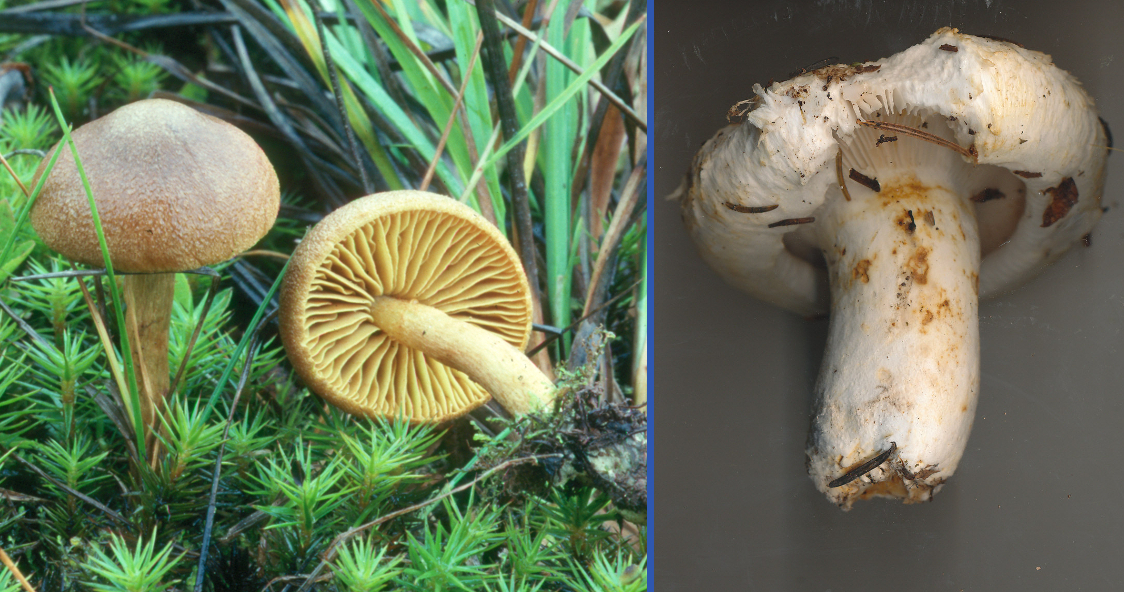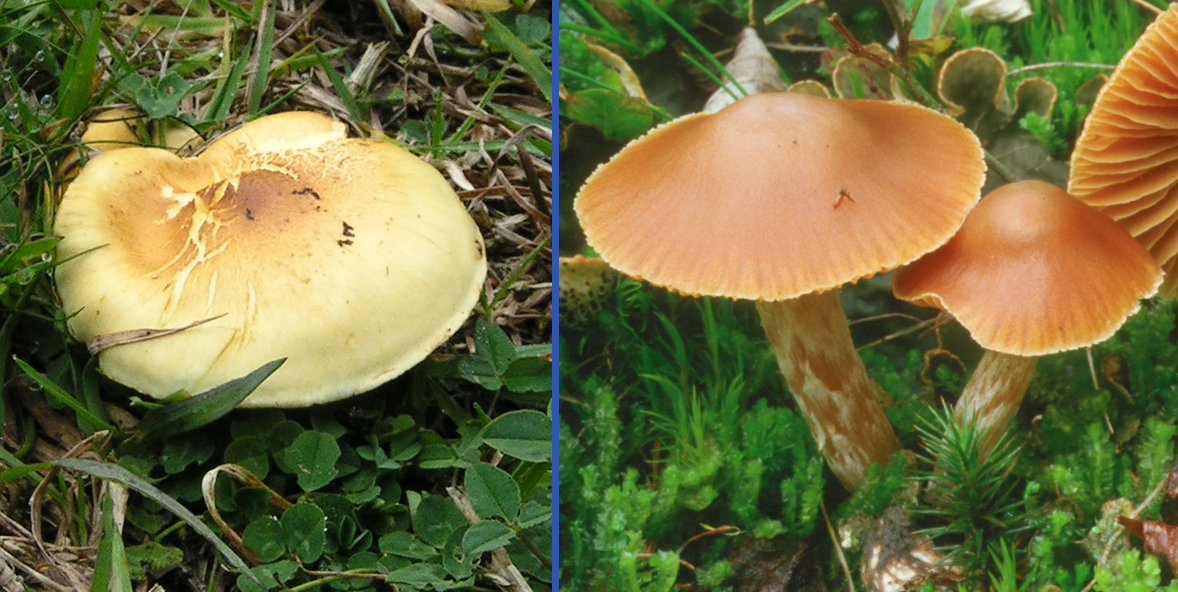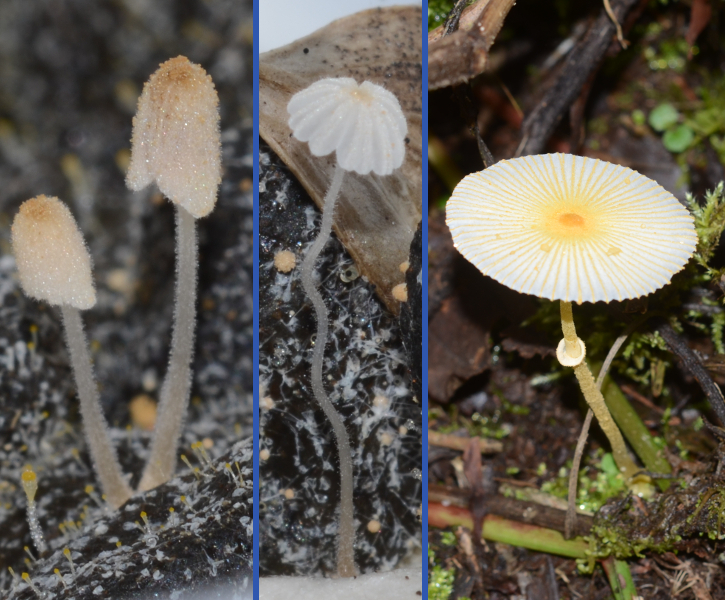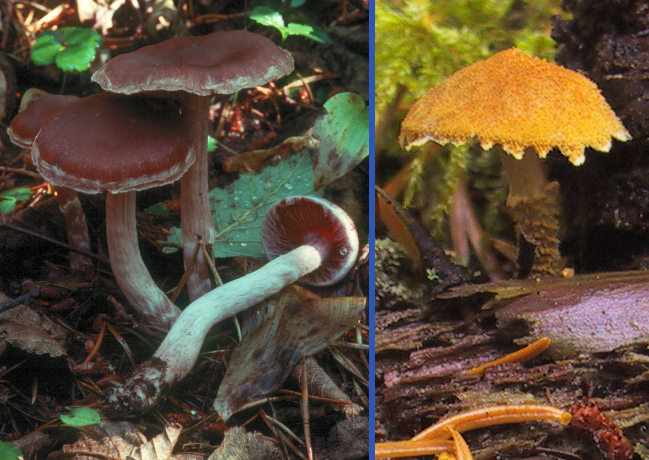PILEUS MARGIN
There are several characteristics of the pileus margin that are useful in identification, yet may not be obvious in dried collections. These features should be recorded when the material is fresh or photographed. There are two main attributes to observe: the shape of the margin and the nature of its surface.
SHAPE
The shape or configuration of the pileal margin varies quite a bit during the maturation of the fruiting body. Thus you may have to use one descriptive term for young specimens and another for older ones. There are a variety of terms in use, but these can be roughly catagorized as incurved, inrolled, straight and uplifted.

Many mushrooms, or perhaps most, have an incurved margin when they are immature. In this condition, the very edge of the pileus points inward toward the stipe. The margin may remain incurved at maturity, as in Cortinarius huronensis, far left, or it may become straight or uplifted in age. In a few species the margin may be actually rolled inward, a condition usually referred to as inrolled. Lactarius deceptivus, at left, and Paxillus involutus have characteristically inrolled margins when they are early in their development.

Some mushrooms have a margin that curves neither inward or outward, but instead seems to point downward and away from the stipe. This condirion is usually described by the terms "straight" or "decurved". The species of Cortinarius, related to C. acutus, at far right has a straight margin similar to that seen in Mycena and Galerina species. The photo immediately to the right shows a mature pileus of Pholiota spumosa with a slightly uplifted or upturned margin. In earlier stages of its development the margin of this pileus would have been incurved.
SURFACE

The leftmost panel above is a picture of Gymnopus dryophilus. It is a remarkably nondescript mushroom with a slightly incurved margin and no striking surface features at all. Compare this with Mycena atroalboides and Cortinarius acutus (L to R) in the next two panels. Both of these mushrooms have rather transluscent caps with the lamellae clearly visible. Such margins are usually referred to as "transluscently striate" or just "striate". Transluscently striate mushrooms are usually hygrophanous, and will not appear striate as they begin to dry.
The panel at far right is a top-down view of the cap of Amanita ceciliae. Here the margin appears striate, but there is a clear differerence from the transluscently striate type. Amanita ceciliae is not hygrophanous and the striations are not due to the lamellae showing through. Instead the surface of the pileus is actually ridged. If you run your finger over it you can feel it. This condition is called "corrugate" or "sulcate" and is found in many species of Amanita and Russula.

An interesting condition is found in some mushrooms, usually small and very delicate ones, that work like little umbrellas. The first two photos at right are of Coprinellus pusillulus. When first formed the caps of C. pusillulus appear to be hardly striate at all, but as they expand the gills split down the middle so the whole cap can open like an umbrella, as has partly happened to the one in the middle panel. This condition is called "plicate" or "plicate-striate". The panel at far right is of Leucocoprinus birnbaumii, a species found in the forest in places with mild winters but is also common indoors in colder regions where it is found in greenhouses and houseplant soils. Leucocoprinus birnbaumii also has a plicate margin with an umbrella-like method of expansion.

Aside from striations, some mushrooms may have remains of the universal veil around the margin. The species (yet to be determined) of Cortinarius at far left has appressed white fibrils around the margin that represent the veil. In Cortinarius species the veil may be white, yellow, red, or other colours and it is important to note them if you can. The photo at far right is of Cystoderma amianthinum. The universal veil in this species often tears away from the stipe during expansion leaving tooth-like remnants hanging off the margin. Such fungi are said to have "appendiculate" margins.
There are many other feartures of the pileus margin that you may observe. The margin can be bearded or like eyelashes in some species of Lactarius or it can be scalloped, toothed, or irregularly torn ("lacerate"). In all cases, just look closely and make note of what you see.